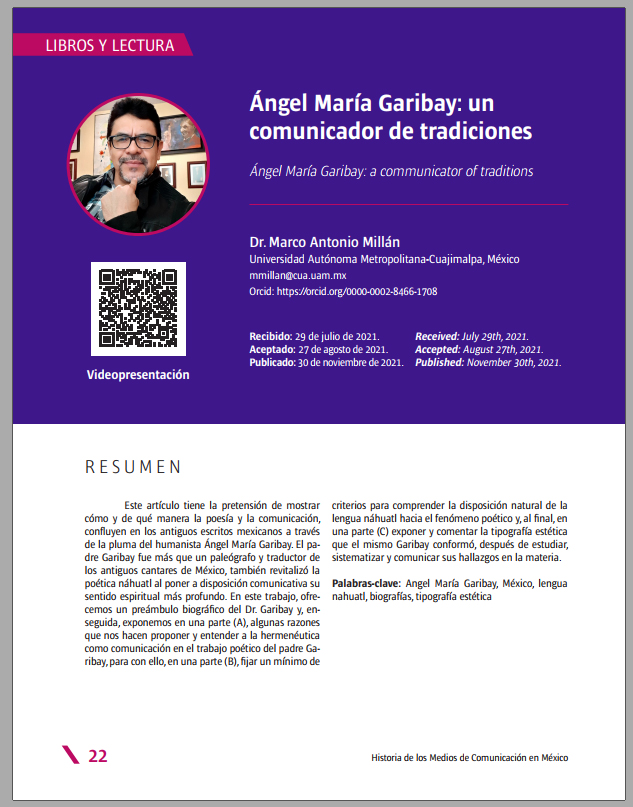Ángel María Garibay a communicator of traditions
Main Article Content
Abstract
This article aims to show how and in what way poetry and communication converge in ancient Mexican writings through the pen of the humanist Ángel María Garibay. Father Garibay was more than a paleographer and translator of the ancient songs of Mexico, he also revitalized Nahuatl poetics by making his deepest spiritual sense available to communication. In this work, we offer a biographical preamble of Dr. Garibay and, next, we will expose in part (A), some reasons that make us propose and understand hermeneutics as communication in the poetic work of Father Garibay, for this, in one part (B), to set a minimum of criteria to understand the natural disposition of the Nahuatl language towards the poetic phenomenon and, at the end, in one part (C) to expose and comment on the aesthetic typography that Garibay himself created, after studying , systematize and communicate their findings on the matter.
Article Details
References
Antón, J.A. (2020), Las imágenes de la aventura, Athenaica.
Antón, J.A. (2018). Intersignos, Athenaica.
Antón, J. A. (2017). El hermetismo cristiano y las transformaciones del logos. Almuzara.
Antón, J. A. (2010). El Ser y los Símbolos. Mandala Ediciones.
Antón, J. A. (2003). Los testigos del instante. Biblioteca Nueva.
Antón, J. A. (1988). Symbolica Nomina. Introducción a la hermenéutica espiritual del libro. Symbolos.
Cáceres, R. (1992). Ángel Ma. Garibay: el poeta. Instituto Mexiquense de Cultura.
Campos, R. (1936). La producción literaria de los aztecas. SEP.
Estrada, F. (Comp). (2002). Tú vivirás para siempre. Poemas a Nezahualcóyotl. Praxis.
Ferraris, M. (2002). Historia de la hermenéutica. Siglo XXI.
Florescano, E. (2020). Dioses y héroes del México antiguo. Taurus.
Fr. Alonso de Molina. (1966) Vocabulario Castellano-Nahuatl (1571). Ediciones Colofón.
Fr. Bernardino de Sahagún. (1956). Historia de las cosas de la Nueva España, Tomos I al IV. Editorial Porrúa. (Numeración, anotaciones y apéndices de Ángel María Garibay).
Gadamer, H-G. (2001). Estética y Hermenéutica. Tecnos.
Gadamer, H-G. (1993). Poema y Diálogo. Gedisa.
Grondin, J. (1999).Introducción a la hermenéutica flosófca. Herder.
León-Portilla, M. (2018). Ángel María Garibay K. Trayectoria y antología. Porrúa.
León-Portilla, M. (2017). Huehuehtlahtolli. Testimonios de la antigua palabra. FCE.
León-Portilla, M. (Ed). (2011). Cantares Mexicanos I y II (tomos 1 y 2). UNAM.
León-Portilla, M. (2006). Literaturas de Anáhuac y del incario. Siglo XXI.
León-Portilla M. y Johansson, P. (1993). Ángel María Garibay: La rueda y el río. Espejo de Obsidiana.
López, A. (1996). Los Mitos del Tlacuache. UNAM.
López, A. (1994) El conejo en la cara de la luna. Ensayos sobre mitología de la tradición mesoamericana. CNCA-Instituto Nacional Indigenista.
López, A. (1989). Hombre-Dios. UNAM.
López, A. (1985). La educación de los antiguos nahuas 1 y 2. SEPEl Caballito.
Ricoeur, P. (2003). El conflicto de las interpretaciones. FCE.
Ricoeur, P. (2020). Antropología Filosófca, B.A.C.
Steiner, G. (2012). La poesía del pensamiento. Siruela-FCE.
Sten, M. (1972). Las extraordinarias historias de los códices mexicanos, Joaquín Mortiz.
Tibón, G. (1975). Historia del nombre y de la fundación de México. FCE.
Valente, J.A. (2008).Obras Completas II. Ensayos.Galaxia Gutemberg.
Zambrano, M. (2011). Claros del Bosque. Cátedra.
Zambrano, M. (2007). Algunos lugares de la poesía. Trotta.
Zambrano, M. (1987). Filosofía y poesía. FCE.


